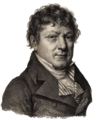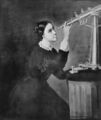Template:Selected anniversaries/August 1: Difference between revisions
No edit summary |
No edit summary |
||
| Line 1: | Line 1: | ||
<gallery> | <gallery> | ||
||1557 | ||1557: Olaus Magnus dies ... archbishop, historian, and cartographer. | ||
||1767: Charles Mason and Jeremiah Dixon finished drawing what some describe as "the world's longest straight line." Actually two straight lines, it forms parts of the boundaries between the U.S. states of Maryland, Pennsylvania, and Delaware. | ||1767: Charles Mason and Jeremiah Dixon finished drawing what some describe as "the world's longest straight line." Actually two straight lines, it forms parts of the boundaries between the U.S. states of Maryland, Pennsylvania, and Delaware. | ||
||Jean-Baptiste Chappe d'Auteroche | ||1796: Jean-Baptiste Chappe d'Auteroche dies ... astronomer, best known for his observations of the transits of Venus in 1761 and 1769. | ||
File:Joseph Priestley.jpg|link=Joseph Priestley (nonfiction)|1774: British scientist [[Joseph Priestley (nonfiction)|Joseph Priestley]] discovers oxygen gas, corroborating the prior discovery of this element by German-Swedish chemist Carl Wilhelm Scheele. | File:Joseph Priestley.jpg|link=Joseph Priestley (nonfiction)|1774: British scientist [[Joseph Priestley (nonfiction)|Joseph Priestley]] discovers oxygen gas, corroborating the prior discovery of this element by German-Swedish chemist Carl Wilhelm Scheele. | ||
| Line 11: | Line 11: | ||
||1779: Lorenz Oken born ... German naturalist who offered early evolutionary ideas and stimulated comparative anatomy. He theorized (incorrectly) that the skull was a modified vertebra, but formed some fundamental concepts which stimulated further thought from later scientists. In Die Zeugung, he discussed “the infusoria”—elementary units of living organisms—into which all flesh can be broken down. Higher animals, he proposed, consisted of constituent animalcules. Entities, whether plants or animals, became organisms by the fusion of these primal animals. Those elements lose all individuality and create a higher unity. Lorenz Oken wrote many books on natural history for students and adults, founded a scholarly journal (contributing most of its articles), and organized scientific congresses. Pic. | ||1779: Lorenz Oken born ... German naturalist who offered early evolutionary ideas and stimulated comparative anatomy. He theorized (incorrectly) that the skull was a modified vertebra, but formed some fundamental concepts which stimulated further thought from later scientists. In Die Zeugung, he discussed “the infusoria”—elementary units of living organisms—into which all flesh can be broken down. Higher animals, he proposed, consisted of constituent animalcules. Entities, whether plants or animals, became organisms by the fusion of these primal animals. Those elements lose all individuality and create a higher unity. Lorenz Oken wrote many books on natural history for students and adults, founded a scholarly journal (contributing most of its articles), and organized scientific congresses. Pic. | ||
||1795 | ||1795: Clas Bjerkander dies ... meteorologist, botanist, and entomologist. | ||
File:Jean Baptiste Joseph Delambre.png|link=Jean Baptiste Joseph Delambre (nonfiction)|1818: Mathematician and astronomer [[Jean Baptiste Joseph Delambre (nonfiction)|Jean Baptiste Joseph Delambre]] uses astronomical equations derived from analytical formulas which detect and prevent [[crimes against mathematical constants]]. | File:Jean Baptiste Joseph Delambre.png|link=Jean Baptiste Joseph Delambre (nonfiction)|1818: Mathematician and astronomer [[Jean Baptiste Joseph Delambre (nonfiction)|Jean Baptiste Joseph Delambre]] uses astronomical equations derived from analytical formulas which detect and prevent [[crimes against mathematical constants]]. | ||
| Line 17: | Line 17: | ||
File:Maria Mitchell.jpg|link=Maria Mitchell (nonfiction)|1819: Astronomer and academic [[Maria Mitchell (nonfiction)|Maria Mitchell]] born. She will be the first American woman to work as a professional astronomer. | File:Maria Mitchell.jpg|link=Maria Mitchell (nonfiction)|1819: Astronomer and academic [[Maria Mitchell (nonfiction)|Maria Mitchell]] born. She will be the first American woman to work as a professional astronomer. | ||
||1842 | ||1842: A parade in Philadelphia, Pennsylvania, U.S., celebrating the end of slavery in the West Indies was attacked by a mob, leading to three days of riots. Pic. | ||
||Ivar Otto Bendixson | ||1861: Ivar Otto Bendixson born ... mathematician. Pic. | ||
File:Radium Jane.jpg|link=Radium Jane|1869: Celebrity time-traveller [[Radium Jane]] falls asleep, relapses into her [[Janet Beta]] state. | File:Radium Jane.jpg|link=Radium Jane|1869: Celebrity time-traveller [[Radium Jane]] falls asleep, relapses into her [[Janet Beta]] state. | ||
||1881 | ||1881: Otto Toeplitz dies ... mathematician and academic. | ||
||1885 | ||1885: George de Hevesy born ... chemist and academic, Nobel Prize laureate. | ||
||1889 | ||1889: Walter Gerlach born ... physicist and academic. | ||
|| | ||1896: William Robert Grove dies ... judge and physical scientist. He anticipated the general theory of the conservation of energy, and was a pioneer of fuel cell technology. He invented the Grove voltaic cell. Pic. | ||
||John Clive Ward | ||1922: Donát Bánki dies ... engineer. | ||
||1924: John Clive Ward born ... physicist. He introduced the Ward–Takahashi identity, also known as "Ward Identity" (or "Ward's Identities"). He made significant contributions to quantum solid-state physics, statistical mechanics and the Ising model. Pic. | |||
||1944: Start of MARK series of computers: The MARK I computer began operation at Harvard University. The IBM Automatic Sequence Controlled Calculator was an electro-mechanical computer. https://en.wikipedia.org/wiki/Harvard_Mark_I | ||1944: Start of MARK series of computers: The MARK I computer began operation at Harvard University. The IBM Automatic Sequence Controlled Calculator was an electro-mechanical computer. https://en.wikipedia.org/wiki/Harvard_Mark_I | ||
||1957 | ||1957: The United States and Canada form the North American Aerospace Defense Command (NORAD). | ||
||1961 | ||1961: U.S. Defense Secretary Robert McNamara orders the creation of the Defense Intelligence Agency (DIA), the nation's first centralized military espionage organization. | ||
||1967 | ||1967: Richard Kuhn dies ... biochemist and academic, Nobel Prize Laureate. | ||
||Erwin Madelung | ||1972: Erwin Madelung dies ... physicist ... specializing in crystal structure, and eventually became a professor. It was during this time he developed the Madelung constant, which characterizes the net electrostatic effects of all ions in a crystal lattice, and is used to determine the energy of one ion. | ||
File:Gary_Powers.jpg|link=Francis Gary Powers (nonfiction)|1977: [[Francis Gary Powers (nonfiction)|Francis Gary Powers]] dies when the news helicopter he is piloting crashes into a field near Encino, Los Angeles killing Powers and the aircraft's only passenger, cameraman George Spears. | File:Gary_Powers.jpg|link=Francis Gary Powers (nonfiction)|1977: [[Francis Gary Powers (nonfiction)|Francis Gary Powers]] dies when the news helicopter he is piloting crashes into a field near Encino, Los Angeles killing Powers and the aircraft's only passenger, cameraman George Spears. | ||
| Line 47: | Line 49: | ||
File:Baron Zersetzung.jpg|link=Baron Zersetzung|1977: Political campaign manager and alleged crime boss [[Baron Zersetzung]] says that [[Francis Gary Powers (nonfiction)|Francis Gary Powers]] "was practically a leftist." | File:Baron Zersetzung.jpg|link=Baron Zersetzung|1977: Political campaign manager and alleged crime boss [[Baron Zersetzung]] says that [[Francis Gary Powers (nonfiction)|Francis Gary Powers]] "was practically a leftist." | ||
||1984 | ||1984: Commercial peat-cutters discovered the preserved bog body of a man, called Lindow Man, at Lindow Moss, Cheshire, North West England. | ||
||1996 | ||1996: Tadeusz Reichstein dies ... chemist and academic, Nobel Prize laureate. | ||
||2004 | ||2004: Philip Abelson dies ... physicist and author. | ||
||2007 | ||2007: Bridge 9340, carrying Interstate 35W across the Mississippi River in Minneapolis, Minnesota, U.S., suffered a catastrophic failure and collapsed (pictured), killing 13 people and injuring 145. | ||
||2015 | ||2015: Bernard d'Espagnat dies ... physicist, philosopher, and author. | ||
</gallery> | </gallery> | ||
Revision as of 07:49, 1 September 2018
1774: British scientist Joseph Priestley discovers oxygen gas, corroborating the prior discovery of this element by German-Swedish chemist Carl Wilhelm Scheele.
1818: Mathematician and astronomer Jean Baptiste Joseph Delambre uses astronomical equations derived from analytical formulas which detect and prevent crimes against mathematical constants.
1819: Astronomer and academic Maria Mitchell born. She will be the first American woman to work as a professional astronomer.
1869: Celebrity time-traveller Radium Jane falls asleep, relapses into her Janet Beta state.
1977: Francis Gary Powers dies when the news helicopter he is piloting crashes into a field near Encino, Los Angeles killing Powers and the aircraft's only passenger, cameraman George Spears.
1977: Political campaign manager and alleged crime boss Baron Zersetzung says that Francis Gary Powers "was practically a leftist."





